Your cart is currently empty!
Is Pottery Dishwasher Safe? Washing Handmade Ceramics
Published:
Last Updated:
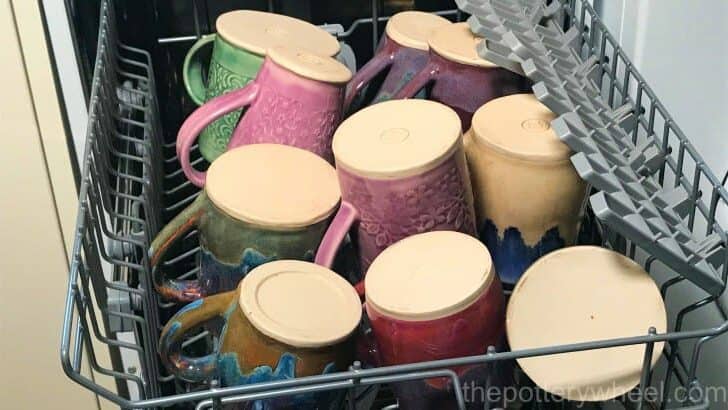
Affiliate Disclaimer
As an affiliate, we may earn a commission from qualifying purchases. We get commissions for purchases made through links on this website from Amazon and other third parties.
It seems to me that everything tastes better when you eat or drink from handmade ceramics. But how do you look after it and is pottery dishwasher safe? In this guide, I’ll be looking at some of the dos and don’ts of washing your pottery. But first, to quickly answer the main question about dishwasher safety…
Pottery that has been made from earthenware clay is porous and therefore not usually dishwasher safe, even when it’s been glazed. Stoneware or porcelain pottery can be washed in the dishwasher if they have been fired to the right temperature, and glazed correctly. Even then a dishwasher can remove some shine from glaze after repeated use.
Is Pottery Dishwasher Safe?
Now let’s take a closer look at some of the things that affect whether you can put your pottery in the dishwasher…
What Does Dishwasher Safe Actually Mean?
It’s worth mentioning that there isn’t a formal definition of what dishwasher safe really means. The ASTM International, (previously the American Society for Testing and Materials), doesn’t provide a definition of dishwasher safety.
However, what it is normally taken to mean is that dishes can cope with the heat, water, and detergents used in a washing cycle, without being damaged. There are various symbols for dishwasher safety, including the one below.
Symbols like this are generally used on commercially mass-produced ceramics. You are much less likely to find a symbol like this on handmade pottery.

via Wikimedia Commons
There are a few features of a dishwashing cycle that make it more aggressive to pottery than regular handwashing. Some of these features are:
Higher Temperatures
The water used in a dishwasher is hotter than hand-washing water. Usually, the temperature of a dishwasher in the main cycle is between 130-140F (55-60C). And during the rinse cycle, the temperature can go up to 180F (82C) (source).
By contrast, most people’s hands can comfortably stand temperatures of around 100F (38C) (source). So, pottery going through a dishwasher cycle has to withstand much higher temperatures.
Alkaline Detergents
Dishwashing detergents are strongly alkaline. This is because alkalis dissolve grease and remove food from the dishes, and protects the dishwasher too. The water in a dishwasher is normally around pH 10, (source).

The difficulty is that whilst the detergents are effective at cleaning dishes, they also dissolve glassy and glazed surfaces (source). Think about what happened the last time you put a drinking glass in the dishwasher. After a few washes, it most likely came out of the washer looking dull and feeling a bit rough.
Putting Pottery in the Dishwasher
So, what does this mean for your pottery? Can you put it in the dishwasher safely? Or will it be ruined?
It would be very nice if there was a straightforward yes or no answer to this question. However, in reality, whether your pottery is dishwasher safe depends on a few factors.
Luckily, if you ask yourself a few questions, you should be able to figure out if you can put your handmade mugs, bowls, and plates in the dishwasher. Or if you’d be better off sticking to washing them by hand.
Here are some of the factors that make pottery dishwashers safe or not…
The Type of Clay Used
Three main types of clay are used to make pottery that you eat and drink from. They are stoneware, earthenware, and porcelain. Each of these responds a bit differently to being in a dishwasher.
It’s likely that when you bought your pottery, the potter included some information about what kind of clay they used. Often potters will describe their pieces as being ‘stoneware mugs’ or ‘porcelain plates’ for example.
However, this information isn’t always provided. So, if you are able, you may need to contact the person you bought the pottery from and double-check with them.
Is Earthenware Pottery Dishwasher Safe?
Pottery is fired (basically baked) in a very hot oven-like piece of equipment called a kiln. When clay is fired, the clay particles bond together and become denser. The denser the pottery, the less porous and the more water-tight it is once it’s been fired.
Exactly how dense the pottery becomes depends upon the ingredients used by the manufacturer when the clay is being processed.
Pottery clay is fired at temperatures that range between 1830F(1000C) and 2381F (1300C). The hotter the temperature the clay is fired at, the denser and the less porous it becomes.
However, some clay can only tolerate being fired at the lower end of the temperature range. These are called low-fire clays, and earthenware falls into this category
When earthenware clay is fired, the clay particles undergo a physical and chemical change. They bond together and become a rigid, insoluble structure. At this point, the clay has been ‘sintered’.
However, at a microscopic level, there are still open pores between the clay particles. So, earthenware clay is quite porous.
If pottery is porous, it absorbs water when it becomes wet. Absorbing water when it’s being washed in itself isn’t a problem. The water will simply evaporate out of the pottery when it’s drying. The problem arises when the water is as hot as it becomes in a dishwasher.
The very hot temperatures of the water in the dishwasher can weaken the clay. As water heats up it expands (source).
Water that has been absorbed into the earthenware and then expands as it heats up puts the pottery under stress.
For that reason, it’s usually recommended that earthenware pottery is hand-washed.

What About Glazed Earthenware Pottery?
One way to make earthenware pottery less absorbent is to glaze it well. Pottery glaze is the glassy cover that is applied to the pot. This coating is designed to decorate and protect the piece.
A lot of pottery glazes do create a moisture barrier between themselves and the underlying clay. Some glazes are watertight, and others are not.
Often the glazes used on earthenware mugs, bowls, and plates will create enough of a seal so that the pottery is suitable for food and drink. This is providing the glaze in question is labeled as being ‘food safe’ by the manufacturers. If you want to know more about food-safe clay, you can check out my article on that subject here.
However, being food-safe is not the same thing as being dishwasher-safe. Here are some of the reasons why even glazed earthenware pottery is not ideally suited to being washed in a dishwasher…
- Some areas of the clay will remain unglazed. The bottom of a foot ring or the whole of the base of the pottery will be unglazed. This unglazed area will remain porous.
- The bond between earthenware clay and glaze is not especially strong. Although the glaze is stuck to the pottery, the glaze sits on top of the clay rather than becoming a mingled part of the clay body.
As such, it can weaken and flake off if the pottery is continually exposed to extreme temperatures and water jets in the dishwasher. Not to mention the general bumps and knocks that dishes can endure in a dishwasher.
Another factor to consider is whether the glaze itself is dishwasher safe. I’ll take a look at that question in a moment. But for now, let’s consider stoneware pottery and whether it fares any better in the dishwasher…
Is Stoneware Pottery Dishwasher Safe?
The materials that make up stoneware clay can cope with being fired at higher temperatures than earthenware clay. For that reason, stoneware is called mid-high fire clay.
Different types of stoneware will have their own firing range, and this will be indicated by the manufacturer on the packaging. However, broadly speaking, stoneware clay will be fired between 2158F (1181C) and 2377F (1300C)
Stoneware clay contains ingredients classified as ‘glass-formers’. When the clay is being fired a mid to high temperatures, these glass formers melt and create a liquid glass.
In its liquid state, the glass fills up any gaps between the clay particles. When the kiln cools down, the glass that is filling up the pores in the clay becomes solid again.
This process is called ‘vitrification’. You have probably seen ceramics being described as ‘vitreous’ or ‘non-virtreous’. Well, these terms are referring in part to how porous or absorbent the ceramic ware is.
Once stoneware clay is fired at the right temperature, the pottery will have a very low porosity of 3% or less. In terms of dishwasher safety, this is a very good thing. It means that the pottery will be resistant to water when it’s being washed, even in a dishwasher.
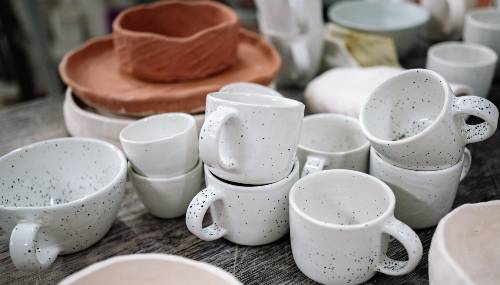
Another reason that stoneware clay is dishwasher friendly is that it is strong and durable. As a result, if it falls over in the dishwasher or bumps into another mug or bowl next to it, it’s less likely to chip or be damaged.
So, stoneware clay, provided it’s fired well and is vitrified, is safe to wash in a dishwasher.
However, before you go putting your handmade pottery into the dishwasher, we also need to consider how the pottery has been glazed.
What About Glazed Stoneware Pottery?
Another reason that stoneware pottery can copes better with being in the dishwasher is to do with what happens when the pottery is glazed.
Unfired pottery glaze is a powdery mixture of ingredients suspended in water. This is applied to the pottery and then put into a glaze firing. During the glaze firing the pottery glaze melts.
When stoneware pottery is glaze fired, the molten glass in the clay described earlier mixes in with the molten glaze. As the kiln and the pottery cool, a very strong bond is created between the pottery and the glaze because of this intermingled layer.
This means that the glaze is much tougher than earthenware glaze. As such, it’s less likely to chip and break off if it gets knocked in the dishwasher.
Dishwasher Safe Ceramic Glaze
But is there such a thing as a dishwasher-safe glaze? Let’s take a look at that question now…
The answer to that question is yes, a lot of glazed ceramic ware is sold as being dishwasher safe. Most commercially made ceramic ware that is produced on a large scale has a symbol underneath to indicate that it can be washed in the dishwasher.
You will also find smaller-scale artisan potters who label their pottery dishwasher safe. This means that the glaze will be able to withstand the heat and detergent used in the dishwasher.
However, glaze manufacturers themselves don’t make claims about whether their glazes are dishwasher-safe or not. And there are good reasons for that. Whether or not a glaze is dishwasher safe depends on the following factors:
Factors that Affect Whether a Glaze is Dishwasher Safe
- The clay needs to be mid to high-fire clay, and it needs to be fired to the point of vitrification. I mentioned above that vitrification occurs when the pottery is fired at a high enough temperature.
This enables some ingredients in the clay to melt and become glass-like filling up the gaps between the clay particles. A glaze is only dishwasher safe when the clay body underneath is vitrified. - There also needs to be a good fit between the clay and the glaze. Not all combinations of clay and glaze work well together. There are different reasons for this, but one of them is that they can expand and shrink at different rates as their temperature changes.
For example, if a glaze shrinks at a higher rate when it cools than the clay underneath, the glaze will be under a lot of tension. This can cause the glaze to crack and craze. For a glaze to be dishwasher safe it needs to be used with a clay body that fits well.
Glaze manufacturers don’t have any control over how their glazes are used, so understandably they are reluctant to make any claims about whether they are dishwasher safe.
What the Glaze Manufacturers Say
I wrote to some key glaze manufacturers to ask them about dishwasher safety and this is how they responded in their email…
- Amaco “we do not test for microwave safety or dishwasher durability. We recommend that all handmade items be hand washed”.
- Mayco “There isn’t a quick and easy answer to your question. The most important factor is having clay that is vitrified and the glaze fit. If both of these are good then you shouldn’t have a problem with dishwashing. If crazing is occurring then the glaze isn’t a good fit”.
- Botz “If an object is dishwasher safe – depends on the clay. So, if the clay is vitrified – you can put your dishes in the dishwasher with or without glaze…you have to know which clay is used exactly and at which temperature this clay is vitrified”.
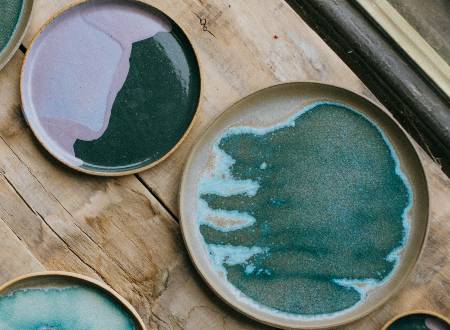
What Are the Risks of Putting Stoneware in the Dishwasher?
If your stoneware pottery has been fired at the right temperature, and the right glaze has been used, then it should be fine to wash in a dishwasher.
However, some potters still prefer not to make claims about dishwasher safety because there are factors at play that they can’t control. Some of these factors are:
- How corrosive the dishwasher detergent is
- The softness or hardness of the water
- The maximum temperature of the dishwasher
In addition to this, there are a couple of things that can happen to pottery overtime if it’s repeatedly washed in a dishwasher
- Exposed areas of clay that haven’t been glazed, like an unglazed base or a foot ring can become a bit discolored.
- Glossy glazes can lose a bit of their shine over time with repeated dishwasher use.
Is Porcelain Pottery Dishwasher Safe?
Like stoneware clay, when porcelain is fired to the right temperature, it is vitrified. In fact, when it’s fired correctly porcelain is the least porous clay body. Some porcelain clays are completely non-porous when they have been fired.
This means that in theory porcelain is a good candidate for being washed in a dishwasher. However, the same things apply to porcelain that apply to stoneware. And that is that the porcelain has to be fired to the right temperature, and if it’s been glazed, the glaze needs to fit the porcelain well.
In addition to this, porcelain is often used to make pottery that has fine details. These can be vulnerable to being bumped and knocked in the dishwasher. Although porcelain is strong, delicate sculpted details can break easily in a dishwasher.
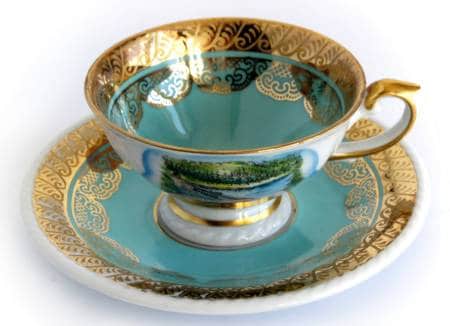
So, whilst a well-fired and glazed porcelain plate might fare well in a dishwasher, a teacup with an ornate handle may not be a good idea.
What Pottery Should Not Go Into the Dishwasher?
There are certain decorative details that do not do well in a dishwasher. Pottery that has been decorated with the following finishes should be hand-washed:
- Metallic lusters, such as gold, platinum, and mother of pearl will become dull if washed in a dishwasher.
- Decals, stickers, and image transfers can fade and lose their detail and precision through repeated cycles in a dishwasher.
If in doubt, it’s always best to check with the potter who made the pieces to confirm whether they are dishwasher safe.
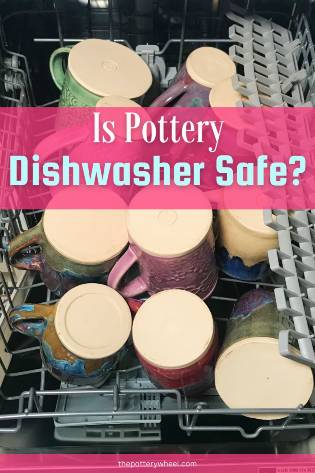
Final Thoughts
If you have bought some pottery from an artisan potter, and they have labeled it as dishwasher safe, then it’s more than likely that your piece will be fine in the dishwasher.
However, it’s worth remembering that with time most ceramics, whether they are handmade or not will lose a bit of their shine after being washed repeatedly in the dishwasher.
There is something wonderful about drinking and eating from handmade pottery, and my feeling is that it’s worth a little extra work to preserve that beauty. Although it’s tempting to put pottery in the dishwasher, I have to confess that I always handwash mine.
If I’ve bought some pottery from an artisan, it’s usually more expensive than a job lot from Ikea. But more than that, it’s a piece of art that I want to look after. And I feel the same way about my own ceramics. It goes against the grain to take time and effort to make something I’m happy with, to then put it in a dishwasher and cross my fingers!
That being said, stoneware and porcelain pottery that has been fired and glazed well are more than likely dishwasher safe. If you are in any doubt, reach out to the potter who made them for some guidance on aftercare.



